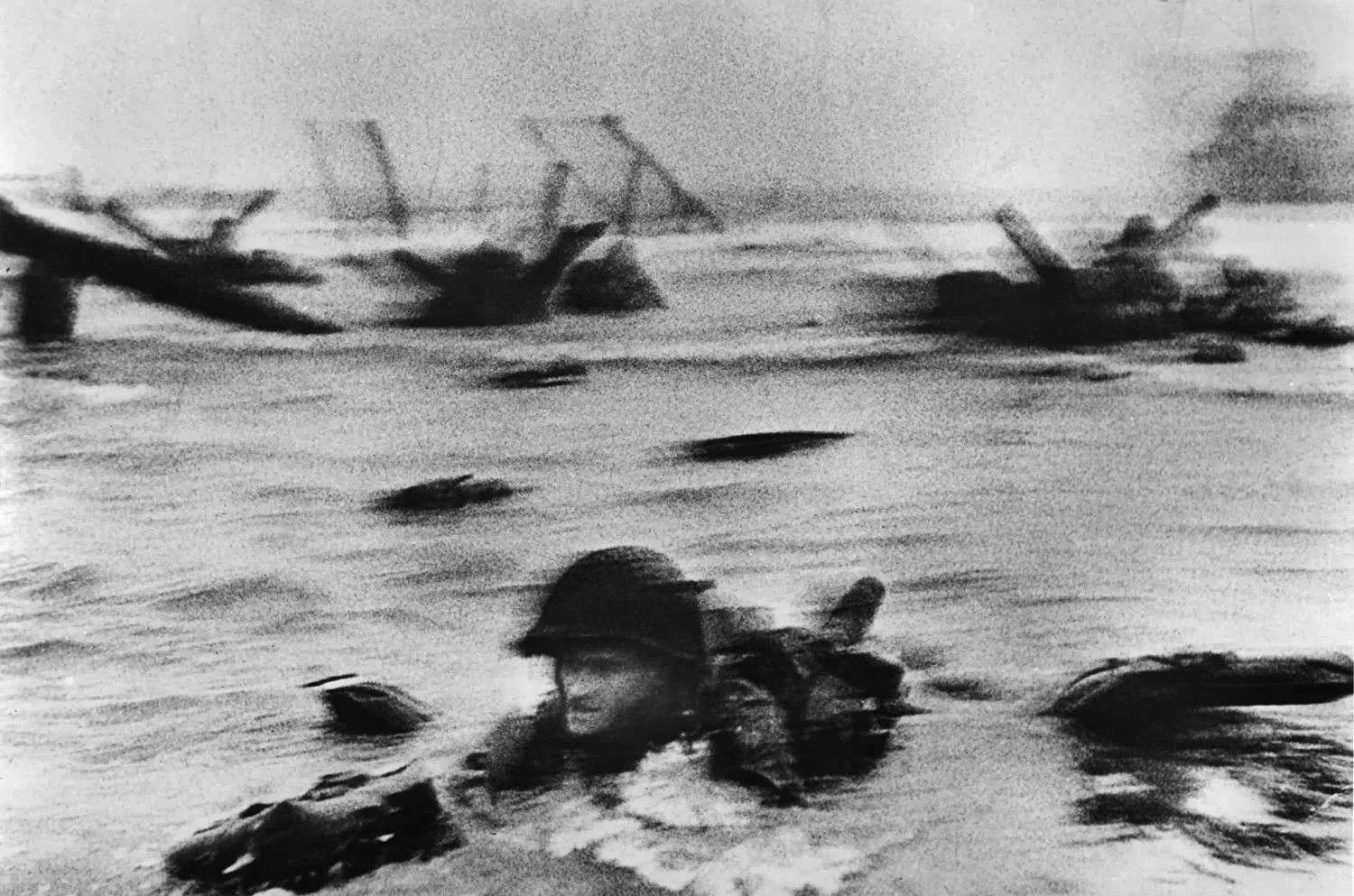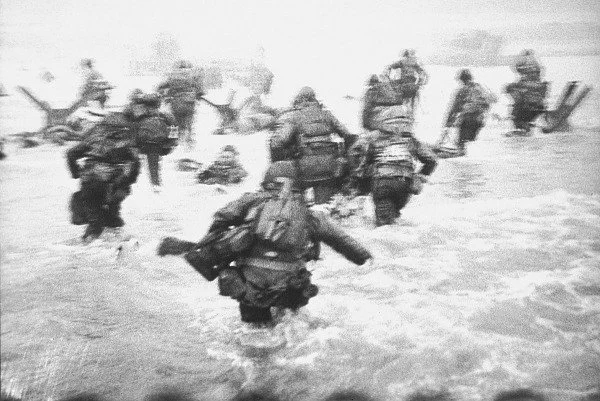Robert Capa (10/22/1913 – 5/25/54), a Hungarian by birth, named Endre Friedmann, moved to Berlin as a young man to study political science in university, and he also learned photography. However, as a Jew, he felt uncomfortable living in Germany in the 1930’s, so he moved to Paris. There he met Gerda Taro, who became his partner and lover. Both photographers, they covered the Spanish Civil War and published their photographs together under the pseudonym, Robert Capa.
When Taro was killed in 1937 in Spain, Endre took the name, Robert Capa, and continued to work. In 1938, Picture Post declared him, “The Greatest War-Photographer in the World,” when they published 26 of his photographs from that war. He then covered the Japanese invasion of China before moving to New York. From there he covered the Africa campaign and the conquest of Sicily and Italy.
He is probably best known for his photographs of the D-Day invasion of Omaha Beach on June 6, 1944. Two of these photographs have become iconic. He continued to cover World War II until VE Day on June 8, 1945. He was killed by a landmine nine years later while covering the war in Indochina.
This series of blog posts deals with only one day of his career, a day that recently has become very controversial. Capa wrote about his experience on the Easy Red sector of Omaha Beach three years later in his memoir, Slightly Out of Focus. He chose the title for several reasons, one of which was his technique of using blurry images to impart a dynamic quality to his pictures, but it was also a metaphor. On the book jacket, he admitted that it was difficult to write the truth and that he allowed himself “to go sometimes slightly beyond and slightly this side of it. All events and persons in this book are accidental and have something to do with the truth.”
Presumably, Capa spiced up this memoir in hopes of it turning into a screenplay. That never happened, and most people who read it take his comment into account. Capa’s D-Day story goes like this: He said he was given options of which group to go in with on D-Day. He wanted to go early, so he chose Easy Company on the first wave. He said he took pictures from the landing craft of men going ashore, and then he said that was sufficient for him, implying he had what he needed. About that time the boatswain kicked him off the ramp because they wanted to get out of there.
He found himself in the water, made for an obstacle to protect him from ordinance coming his way, and started taking pictures. He then jumped to a tank located closer to the shoreline, and from there he made it to shore. Once on shore he took out his second camera and took an entire roll of pictures. When he started to change out the film from that camera he described having a panic attack. He sprang up and, with both cameras held over his head, he waded out to a ship that had just off-loaded some medics. From there, he went to his mother ship and then to Weymouth, England, where he sent his pictures by courier to the offices of Life magazine in London. He then headed back to Normandy to keep photographing.
Critics question the precise time he arrived Easy Red and with whom. They question how long he stayed there. They question exactly how many pictures he took there. They say that he went in late, after the action had died down; that he did not plan to get off his landing craft; that his pictures don’t show heroic men under fire, but rather a command unit that landed under relatively quiet conditions; that he freaked out and made for the first boat that could take him out of there.
But that’s not all to the story. Once the film finally arrived at the Life office, about 36 hours after he took the pictures, they were received by John Morris, the picture editor. Morris told the darkroom staff to develop the film and make it snappy, because they had a hard deadline looming if they wanted to make the next issue of Life magazine. The negatives needed to be developed, edited, couriered to the airport, flown to Scotland, then to Washington and New York. At first, Morris received word from the darkroom that the pictures looked “fabulous.” A short while later, a young “darkroom lad” named Dennis Banks, told the horrified Morris that the negatives were ruined. In his haste to dry them, he had put a heater in the drying cabinet and turned up the heat higher than normal. He said this melted the emulsion. All of the precious images from those two rolls of film were gone, except for the magnificent last 10 (or 11) on the first roll, the ones Capa made when he first arrived at Easy Red. Morris made the deadline, the pictures were published, and the world got a glimpse of what it looked like that morning on Omaha Beach.
The same critics who are skeptical of Capa’s activities on D-Day question this story, too. First of all, why did Morris entrust these precious negatives to an inexperienced, 15-year-old “darkroom lad?” Secondly, does heat cause emulsion to melt? They did the experiment; they processed some exposed black and white film and dried it in a very hot drying cabinet. It came out fine. No melting. Based on this, and some other nuances I will discuss in subsequent posts, these critics declared that, not only did Capa fabricate large portions of his experience on Easy Red, but he and Morris concocted this darkroom “mishap myth” to cover for Capa’s lackluster performance. Rather than a failure it made them both look heroic. Morris continued to tell this story after Capa’s death, including in a book, in various documentaries and televised interviews. It has become a legend in photojournalism.
Capa’s reputation of heroism is so enduring that the Overseas Press Club annually awards an intrepid photographer working in a conflict zone the Robert Capa Gold Medal for “exceptional courage and enterprise.” Capa’s pictures from that day have become iconic. Morris went on to have a storied career as a picture editor at many magazines and he was Executive Director for years at Magnum Photos, the renowned photo agency created by Robert Capa, Henri Cartier-Bresson, and others in 1947.
In 2014, the Pulitzer Prize recipient, J. Ross Baughmam, published an article on Allan D. Coleman’s website, Nearby Café, questioning the above narrative. This launched an investigation that continues to this day and has attracted other contributors, such as Charles Herrick, Rob McElroy, Tristan Da Cunha, and others. Herrick wrote a book covering their analysis, Back Into Focus. This group has made many fine and interesting discoveries, which I will review in this blog. But their ultimate conclusions are flawed, in my opinion, and I will show those flaws in the following blog posts.
My purpose in doing this is to provide a different interpretation of the events some 81 years ago, to counterbalance the accusations and downright sneers promulgated by Coleman and his colleagues. I have no connection to Capa, Morris or Magnum. I belong to a number of photography organizations, just to support them, including the International Center of Photography (ICP). About all I get out of it is a newsletter, so I don’t view that as a conflict of interest. The ICP is one of the organizations that Coleman and his colleagues impune as part of this vast conspiracy. He refers to the people and organizations that have supposedly promulgated these lies for decades as the “Capa Consortium.”
Since the phrase, “Coleman and his colleagues,” is somewhat unwieldy, I have taken inspiration from Coleman’s, “Capa Consortium,” to refer to this group as the Coleman Clan, or simply, the Clan. When I use these terms I may be referring to the entire group, or possibly just two or more contributors. My use of the term, clan, is not meant to imply or conjure Ku Klux Klan. Rather, think of a group of Scotsmen working on a common project.
If you read on, you will see that the discussion can get pretty technical. It references pictures and diagrams that I will include embedded in each post. If you have an interest in Robert Capa or John Morris, photojournalism, documentary photography, World War II, D-Day, Omaha Beach, Easy Red sector, or just a general interest, I promise you will find this fascinating. Have fun and please feel free to comment. I’m happy to learn where I may be wrong and I’d love to hear your thoughts.
Below this is a list of the references that I use in the blog posts. Above photograph was obtained from the Britannica website without attribution. https://www.britannica.com/biography/Robert-Capa
1. https://www.nearbycafe.com/artandphoto/photocritic/major-stories/major-series-2014/robert-capa-on-d-day/
2. Herrick, S. (2024) Back in Focus: The Real Story of Robert Capa’s D-Day, Casemate Publishers.
3. Wertenbaker, C. (1944) Invasion! D. Appleton-Century, Co.
4. Capa, R. Slightly out of Focus. New York: The Modern Library, 2001. All quotations from this book come from pages 140-151
5. https://www.nearbycafe.com/artandphoto/photocritic/2024/07/24/alternate-history-robert-capa-on-d-day-54b/
6. https://www.nearbycafe.com/artandphoto/photocritic/2016/12/07/alternate-history-robert-capa-and-john-morris-a/
7. https://www.nearbycafe.com/artandphoto/photocritic/2014/06/29/alternate-history-robert-capa-on-d-day-8/
8. https://overseaspressclubofamerica.submittable.com/submit
9. https://www.nearbycafe.com/artandphoto/photocritic/2015/05/17/guest-post-16-rob-mcelroy-on-robert-capa-2-a/
10. Ambrose, S. (1995) D-Day, June 6, 1944: The Climactic Battle of WWII. Touchstone/Simon & Schuster.
11. https://www.liquisearch.com/czech_hedgehog/technical_details
12. Herrick, pp. 168-9
13. ibid., p. 173
14. ibid., p. 174
15. Ambrose, p. 320
16. https://explore.britannica.com/study/omaha-beach-typical-cross-section-and-obstacles
17. Wertenbaker, pp. 42-3
18. https://www.nearbycafe.com/artandphoto/photocritic/2014/06/06/guest-post-11-j-ross-baughman-on-robert-capa/
19. Ambrose, p. 307
20. ibid., p. 339
21. Herrick, p.108
22. https://warchronicle.com/16th-infantry-situation-on-d-day/
23. https://www.politico.com/magazine/story/2014/06/the-man-who-took-omaha-beach-107509/
24. https://valor.militarytimes.com/recipient/recipient-22728/recipient-22728-2dsc-1/
25. Ambrose, p. 395
26. https://marathonhandbook.com/average-human-sprint-speed/
27. https://www.nearbycafe.com/artandphoto/photocritic/2015/02/12/alternate-history-robert-capa-on-d-day-21/
28. https://tdacunha.com/robert-capa/
29. Herrick, p. 245
30. https://www.nearbycafe.com/artandphoto/photocritic/2019/06/06/guest-post-28-charles-herrick-on-capas-d-day-j/
31. Herrick, p. 269
32. https://www.nearbycafe.com/artandphoto/photocritic/2014/06/08/guest-post-11-j-ross-baughman-on-robert-capa-b/
33. Herrick, p. 199
34. https://www.nearbycafe.com/artandphoto/photocritic/2022/02/08/alternate-history-robert-capa-on-d-day-51/
35. https://warchronicle.com/16th-infantry-situation-on-d-day/
36. https://www.nearbycafe.com/artandphoto/photocritic/2015/08/02/alternate-history-robert-capa-on-d-day-25/
37. https://www.nearbycafe.com/artandphoto/photocritic/2015/08/02/alternate-history-robert-capa-on-d-day-25/
38. https://www.nearbycafe.com/artandphoto/photocritic/2019/02/12/alternate-history-robert-capa-on-d-day-40a/
39. https://www.nearbycafe.com/artandphoto/photocritic/2019/05/20/guest-post-27-charles-herrick-on-capas-d-day-i/
[Ed. note: Clan vs Klan clarified on 12/2/2025.]











